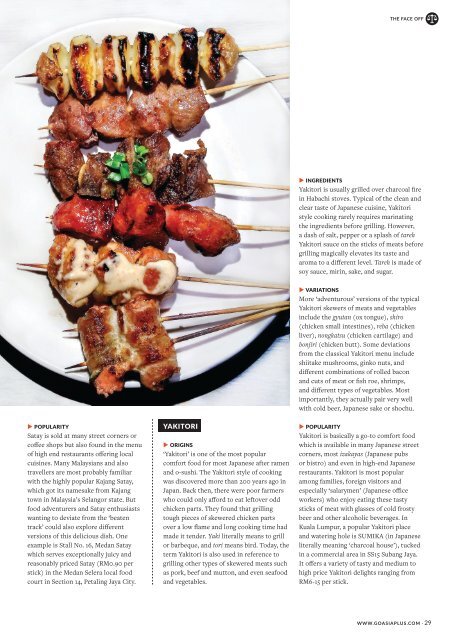GOASIAPLUS October 2018
Our October issue is out with fashion foodie Sara Khong gracing the covers. On the inside, explore the Maldives of Indonesia through Francis' eyes, the millenial's take on travelling abroad for concerts and Bukit Jalil's transformation into Kuala Lumpur.
Our October issue is out with fashion foodie Sara Khong gracing the covers. On the inside, explore the Maldives of Indonesia through Francis' eyes, the millenial's take on travelling abroad for concerts and Bukit Jalil's transformation into Kuala Lumpur.
Create successful ePaper yourself
Turn your PDF publications into a flip-book with our unique Google optimized e-Paper software.
THE FACE OFF<br />
INGREDIENTS<br />
Yakitori is usually grilled over charcoal fire<br />
in Habachi stoves. Typical of the clean and<br />
clear taste of Japanese cuisine, Yakitori<br />
style cooking rarely requires marinating<br />
the ingredients before grilling. However,<br />
a dash of salt, pepper or a splash of tareh<br />
Yakitori sauce on the sticks of meats before<br />
grilling magically elevates its taste and<br />
aroma to a different level. Tareh is made of<br />
soy sauce, mirin, sake, and sugar.<br />
POPULARITY<br />
Satay is sold at many street corners or<br />
coffee shops but also found in the menu<br />
of high end restaurants offering local<br />
cuisines. Many Malaysians and also<br />
travellers are most probably familiar<br />
with the highly popular Kajang Satay,<br />
which got its namesake from Kajang<br />
town in Malaysia’s Selangor state. But<br />
food adventurers and Satay enthusiasts<br />
wanting to deviate from the ‘beaten<br />
track’ could also explore different<br />
versions of this delicious dish. One<br />
example is Stall No. 16, Medan Satay<br />
which serves exceptionally juicy and<br />
reasonably priced Satay (RM0.90 per<br />
stick) in the Medan Selera local food<br />
court in Section 14, Petaling Jaya City.<br />
YAKITORI<br />
ORIGINS<br />
‘Yakitori’ is one of the most popular<br />
comfort food for most Japanese after ramen<br />
and o-sushi. The Yakitori style of cooking<br />
was discovered more than 200 years ago in<br />
Japan. Back then, there were poor farmers<br />
who could only afford to eat leftover odd<br />
chicken parts. They found that grilling<br />
tough pieces of skewered chicken parts<br />
over a low flame and long cooking time had<br />
made it tender. Yaki literally means to grill<br />
or barbeque, and tori means bird. Today, the<br />
term Yakitori is also used in reference to<br />
grilling other types of skewered meats such<br />
as pork, beef and mutton, and even seafood<br />
and vegetables.<br />
VARIATIONS<br />
More ‘adventurous’ versions of the typical<br />
Yakitori skewers of meats and vegetables<br />
include the gyutan (ox tongue), shiro<br />
(chicken small intestines), reba (chicken<br />
liver), nongkatsu (chicken cartilage) and<br />
bonjiri (chicken butt). Some deviations<br />
from the classical Yakitori menu include<br />
shiitake mushrooms, ginko nuts, and<br />
different combinations of rolled bacon<br />
and cuts of meat or fish roe, shrimps,<br />
and different types of vegetables. Most<br />
importantly, they actually pair very well<br />
with cold beer, Japanese sake or shochu.<br />
POPULARITY<br />
Yakitori is basically a go-to comfort food<br />
which is available in many Japanese street<br />
corners, most izakayas (Japanese pubs<br />
or bistro) and even in high-end Japanese<br />
restaurants. Yakitori is most popular<br />
among families, foreign visitors and<br />
especially ‘salarymen’ (Japanese office<br />
workers) who enjoy eating these tasty<br />
sticks of meat with glasses of cold frosty<br />
beer and other alcoholic beverages. In<br />
Kuala Lumpur, a popular Yakitori place<br />
and watering hole is SUMIKA (in Japanese<br />
literally meaning ‘charcoal house’), tucked<br />
in a commercial area in SS15 Subang Jaya.<br />
It offers a variety of tasty and medium to<br />
high price Yakitori delights ranging from<br />
RM6-15 per stick.<br />
WWW.<strong>GOASIAPLUS</strong>.COM · 29

















